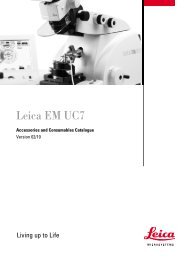Physical Principles of Electron Microscopy: An Introduction to TEM ...
Physical Principles of Electron Microscopy: An Introduction to TEM ...
Physical Principles of Electron Microscopy: An Introduction to TEM ...
You also want an ePaper? Increase the reach of your titles
YUMPU automatically turns print PDFs into web optimized ePapers that Google loves.
72 Chapter 3<br />
The second condenser (C2) lens is a weak magnetic lens (f � several<br />
centimeters) that provides little or no magnification ( M � 1) but allows the<br />
diameter <strong>of</strong> illumination (d) at the specimen <strong>to</strong> be varied continuously over a<br />
wide range. The C2 lens also contains the condenser aperture (the hole in<br />
the condenser diaphragm) whose diameter D can be changed in order <strong>to</strong><br />
control the convergence semi-angle � <strong>of</strong> the illumination, the maximum<br />
angle by which the incident electrons deviate from the optic axis.<br />
The case <strong>of</strong> fully-focused illumination is shown in Fig. 3-8a. <strong>An</strong> image<br />
<strong>of</strong> the electron source is formed at the specimen plane (image distance v0),<br />
and the illumination diameter at that plane is therefore d0 = M d1 (� d1 if<br />
object distance u � v0). This condition provides the smallest illumination<br />
diameter (below 1 �m), as required for high-magnification imaging. Because<br />
the condenser aperture is located close <strong>to</strong> the principal plane <strong>of</strong> the lens, the<br />
illumination convergence angle is given by 2�0 � D/v0 � 10 -3 rad = 1 mrad<br />
for D = 100 �m and v0 = 10 cm.<br />
Figure 3-8b shows the case <strong>of</strong> underfocused illumination, in which the<br />
C2 lens current has been decreased so that an image <strong>of</strong> the electron source is<br />
formed below the specimen, at a larger distance v from the lens. Because the<br />
specimen plane no longer contains an image <strong>of</strong> the electron source, the<br />
diameter <strong>of</strong> illumination at that plane is no longer determined by the source<br />
diameter but by the value <strong>of</strong> v. Taking v = 2v0, for example, simple geometry<br />
gives the convergence semi-angle at the image as ��D/v ��0/2 and the<br />
illumination diameter as d � (2�)(v � v0) ��0v0 = 50 �m. As shown by the<br />
dashed lines in Fig. 3-8b, electrons arriving at the center <strong>of</strong> the specimen at<br />
the previous angle �0 relative <strong>to</strong> the optic axis (as in Fig. 3-8a) would have<br />
<strong>to</strong> originate from a region outside the demagnified source, and because there<br />
are no such electrons, the new convergence angle � <strong>of</strong> the illumination must<br />
be smaller than �0. Using the brightness-conservation theorem, Eq. (3.4), the<br />
product (�d) must be the same at the new image plane and at the specimen,<br />
giving � = �0 (d0/d) � (0.5mrad)(1�m/50�m) � 0.010 mrad. Defocusing the<br />
illumination therefore ensures that the incident electrons form an almost<br />
parallel beam. This condition is useful for recording electron-diffraction<br />
patterns in the <strong>TEM</strong> or for maximizing the contrast in images <strong>of</strong> crystalline<br />
specimens and is obtained by defocusing the C2 lens or using a small C2<br />
aperture,<br />
or both.<br />
The situation for overfocused illumination, where the C2 current has<br />
been increased so that the image occurs above the specimen plane, is shown<br />
in Fig. 3-8c. In comparison with the fully-focused condition, the illumination<br />
diameter d is again increased and the convergence semi-angle � at the<br />
specimen plane is reduced in the same proportion, in accordance with the<br />
brightness theorem. Note that this low convergence angle occurs despite an



